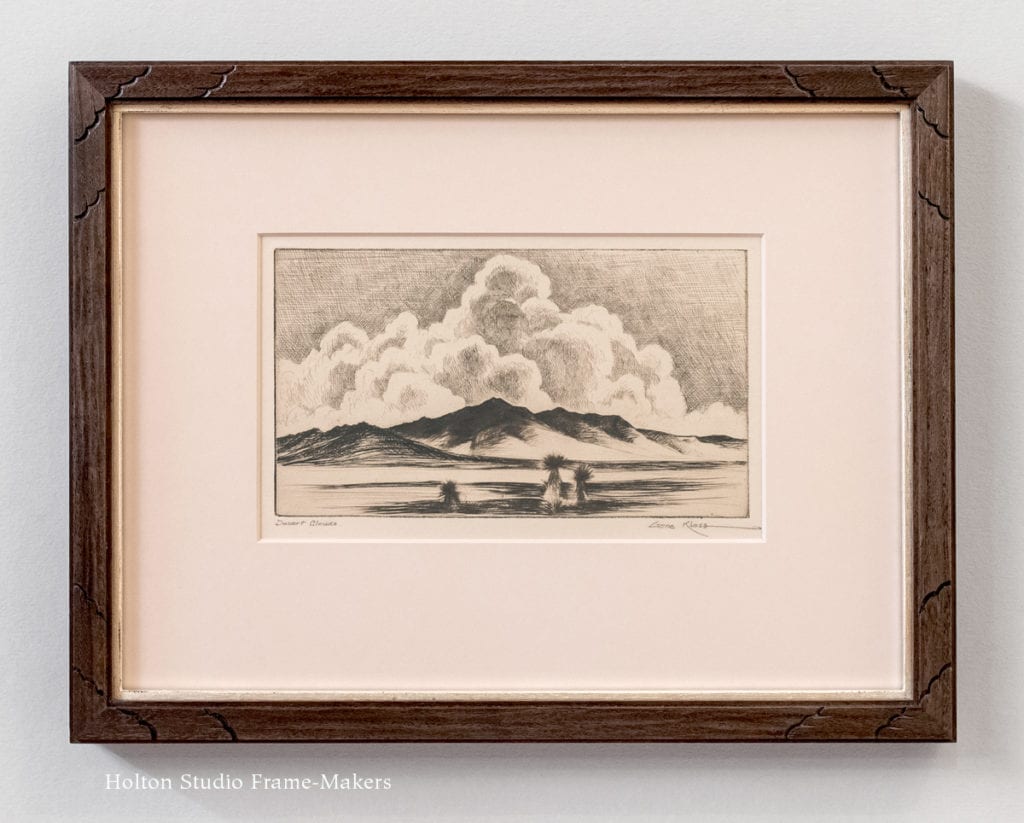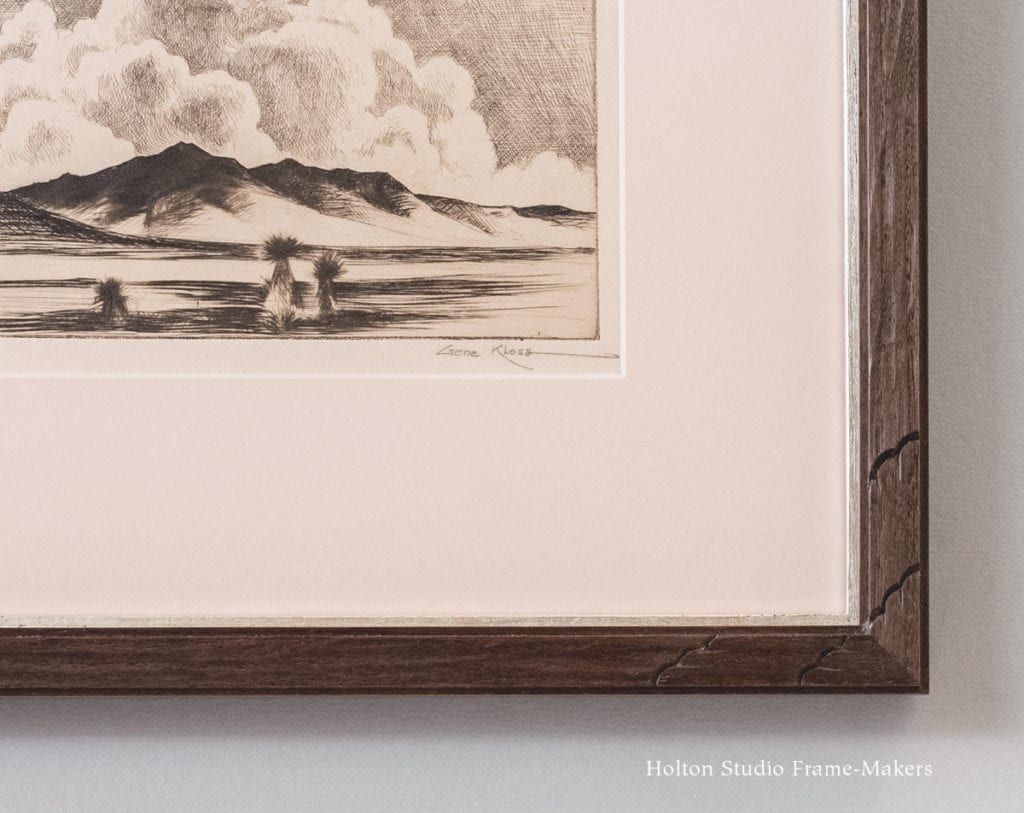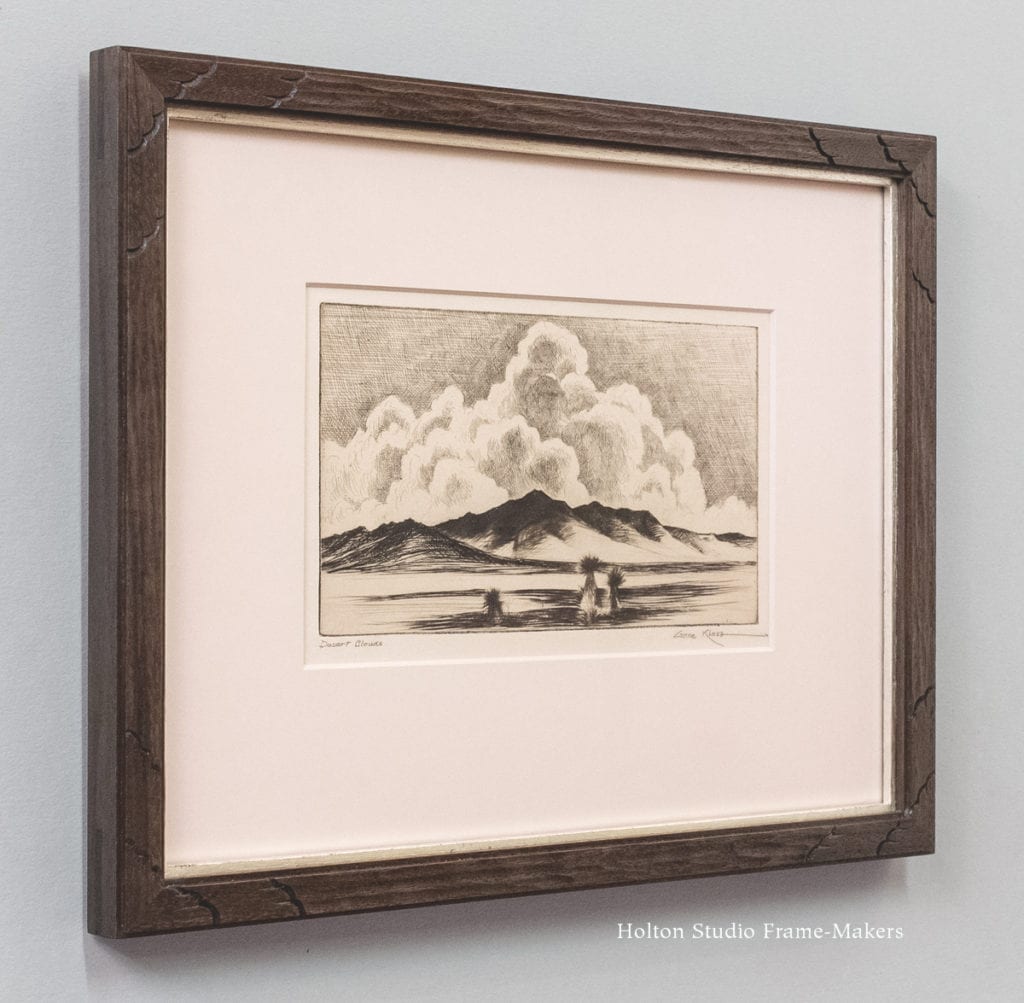“The system of the world is entirely one; small things and great are alike part of one mighty whole.” —John Ruskin, Modern Painters
Theologians of old used to speak of “this great frame of things,” meaning the comprehensive, whole—and holy—totality of creation. It seems to me that the picture frame’s function is to connect the particular, personal, and individual vision that is a picture to the world of which it’s a part, and thus to help make it, small as it is, a part of that totality. For that reason, imagery like leaves and clouds, the most commonplace and ubiquitous things populating the natural creation, have always felt to frame-makers especially suitable as decorative elements for the frame.
 The design of our small frame for this little 4″ x 7″ etching by Gene Kloss (1903-1996), called “Desert Clouds,” 1932, illustrates the point. The outside dimensions of the frame are about 10″ x 13″. It’s a 5/8″ wide profile in walnut with a black wash. We also gave the frame an 1/8″ walnut filet gilded with white gold leaf. The corners are carved in a cloud motif.
The design of our small frame for this little 4″ x 7″ etching by Gene Kloss (1903-1996), called “Desert Clouds,” 1932, illustrates the point. The outside dimensions of the frame are about 10″ x 13″. It’s a 5/8″ wide profile in walnut with a black wash. We also gave the frame an 1/8″ walnut filet gilded with white gold leaf. The corners are carved in a cloud motif.
Such naturalistic decorative motifs as this help the frame in its work of relating the particular to the whole—first and foremost connecting the picture to the natural world that inspired it, but also to the other arts that comprise architecture, and the individual artist and his or her personal vision to the communal life that it touches. It’s reasonable to surmise that this power of naturalistic motifs, their power to connect the works of humanity to the works of nature, explains their ubiquity in human history and its arts, including the most utilitarian arts, going back to our earliest artifacts.
With respect to picture frames, this is a key way in which a frame complements—completes and perfects—another art form, that of the pictorial artist. But it may be only one expression and aspect of a more fundamental principle. The frame not only provides protection and a way of making it physically possible to hang the picture so that it can take its place and role in a room, but, as a decorative architectural setting made of beautiful natural materials and employing naturalistic motifs (and/or more abstract forms derived from nature’s), the frame expresses the picture’s significance in relation to the wider world—and truly and most compellingly, to the world as a whole. Certainly such a frame connects—joins—the picture to its surroundings in a satisfying fashion—much more satisfying than, say, push pins. But its effectiveness and meaningfulness—its evident power in elevating and bringing significance to a picture—may depend even more so on its inherently resonant nature as a powerful symbol, and sort of minor agent or emissary, of that comprehensive “great frame of things”—the vast creation that surrounds us. And perhaps the well-made, well-suited frame satisfies us because it satisfies our innate longing to see, grasp and recognize the connection of the particular to the whole; of each to all; of the individual and the personal to the whole of humanity, nature, and the universe.
The twentieth century propagated a myth of the separateness and autonomy of the “fine” artist and the “fine” art object—a fallacious myth that is, I believe, at the root of the degradation and demise of the “lesser art” of the frame over the past century. The myth broke with and violated a kind of primal unity inclusive of the arts and that didn’t differentiate “artist” from “artisan”; a habitual overlapping, collaboration and mutual aid and interest characteristic of the arts throughout the history of civilization. But more than that, the fallacy defied a natural harmony—a fundamental interconnectedness and interdependence—that ancient wisdom understood, and modern science has increasingly recognized, as a governing characteristic of the infinitely varied and complex, but ultimately unified system and “great frame of things” that is the observable world. We are learning, if too slowly, that, as Wendell Berry says,
Nothing exists for its own sake, but for a harmony greater than itself which includes it. A work of art, which accepts this condition, and exists upon its terms, honors the Creation, and so becomes a part of it.
In the case of pictures—no matter how small—it is the right frame, thoughtfully designed and carefully made, that allows us to see the picture as a part of the wider Creation. Simple though it may be, it is the opposite of the brutally bland, insensate and indifferent, minimalist twentieth century frame that was made for a disconnected, isolated conception of the autonomous work of art. With the help of frames, made again with thoughtfulness, craftsmanship and integrity, we may again learn to connect the visions we have of and for the world to that world. We may again learn to allow pictures—those most concentrated creations of the human imagination, memory, intellect and spirit—to help us attend to that world, to our world, and play our part in its harmony and its wholeness.
Gene Kloss
 Alice Geneva “Gene” Kloss was born in our neighboring Oakland, went to college and lived here in Berkeley. (See her page on the Berkeley Historical Plaque Project website, here.) But after honeymooning in New Mexico she fell in love with that state, longing for a life it offered, amidst the great frame of magnificent mountains, skies and wilderness—a life evident in this print. So she began living there a good part of the year. When Kloss made this etching, she and her husband were living in Taos, in an old adobe at the foot of the Sangre de Cristo Mountains. Wise to the great interdependence of our own creation with nature’s, she once wrote, “An artist must keep in close contact with nature and man’s fundamental reliance on nature in order to produce a significant body of work.”
Alice Geneva “Gene” Kloss was born in our neighboring Oakland, went to college and lived here in Berkeley. (See her page on the Berkeley Historical Plaque Project website, here.) But after honeymooning in New Mexico she fell in love with that state, longing for a life it offered, amidst the great frame of magnificent mountains, skies and wilderness—a life evident in this print. So she began living there a good part of the year. When Kloss made this etching, she and her husband were living in Taos, in an old adobe at the foot of the Sangre de Cristo Mountains. Wise to the great interdependence of our own creation with nature’s, she once wrote, “An artist must keep in close contact with nature and man’s fundamental reliance on nature in order to produce a significant body of work.”
The “Desert Clouds” etching dates from the Great Depression. According to Wikipedia, “Kloss received widespread recognition and awards during the 1930s. From 1933 to 1944 Kloss was the sole etcher employed by the Public Works of Art Project. Her series of nine New Mexico scenes from that period were reproduced and distributed to public schools across the state,” helping children connect to their place on the Earth and learn that, in the words of Woody Guthrie, “this land is your land, this land is my land.”
If the country might be said to have fallen apart with the economic collapse, setting millions of citizens adrift, Kloss’s work is an example of how a people puts things back together using their arts—which are, after all, how we join the world, each of us playing a small part in the whole creation, “this great frame of things.”
« Back to Blog